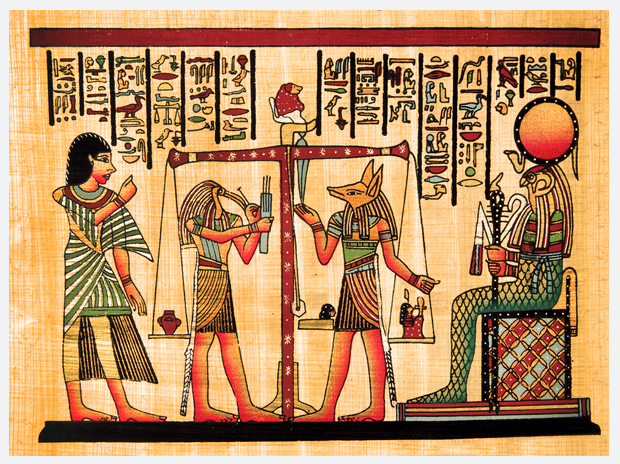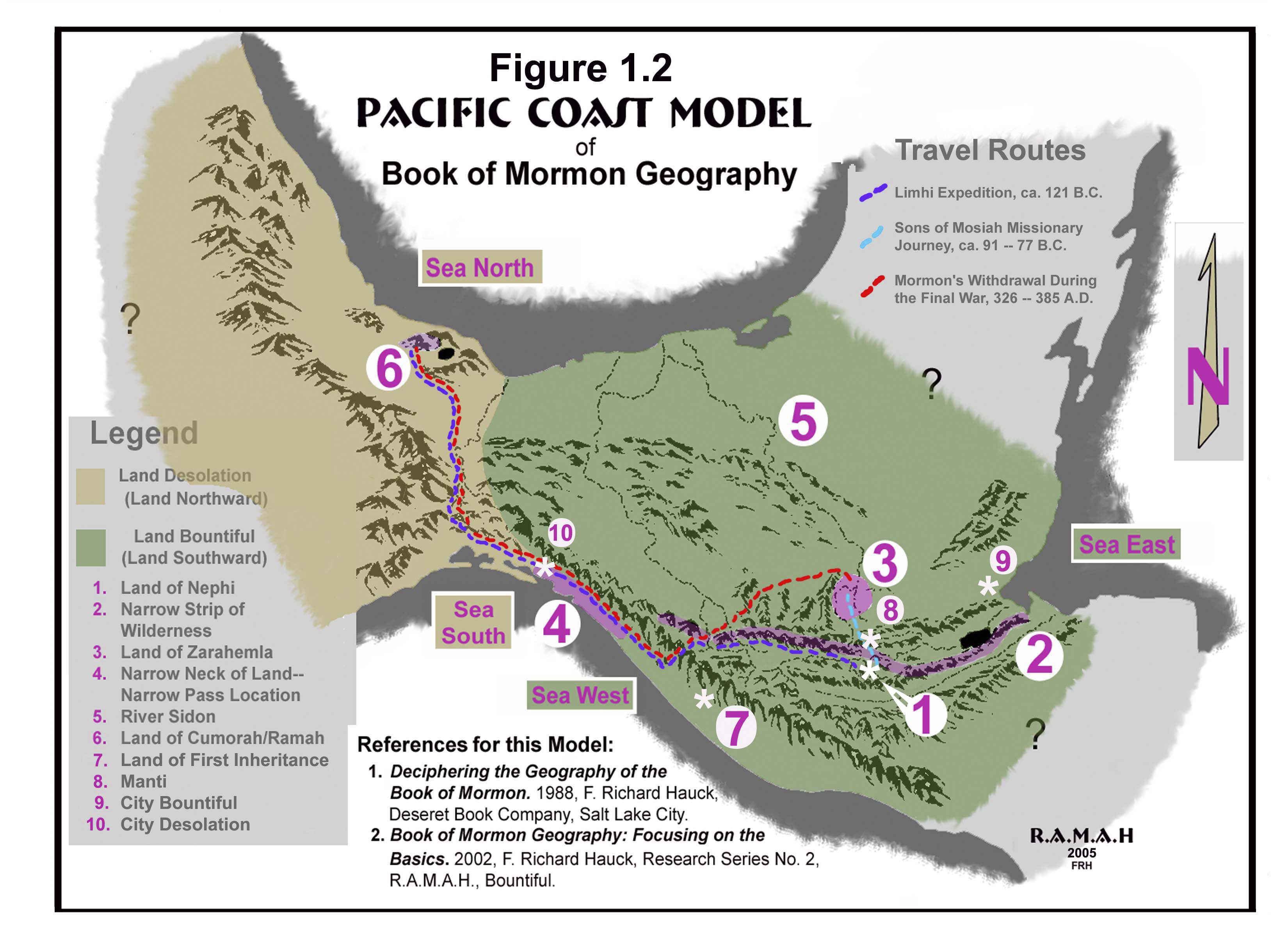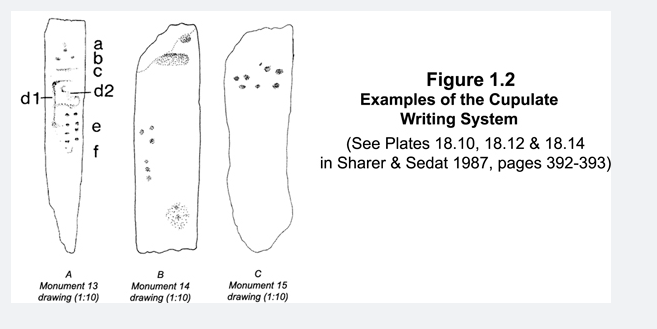The Mesoamerican Model
Meso American Model By Richard Hauck Ph.D

Easy answers being so rapidly generated by proponents of the “Heartland Theory” and various other North and South American settings for the Book of Mormon cannot be valid when those answers disregard the most basic geographical evidence presented in the book. Furthermore, they completely ignore the vast amount of factual evidence that has been compiled concerning the ancient cultures and environments of North and South America—factual evidence which does not mesh with the cultures and environments described in the Book of Mormon.
This series of short articles addresses the fundamental issues posed by the Book of Mormon, clearly demonstrating that the setting described in the book readily conforms to the factual evidence for ancient Mesoamerica (see Figure 1.1 below) and not North or South America.
This first article addresses the key issue of writing. The presence of writing in any given culture should never be confused with inscriptions and symbols found on random artifacts of unknown origin. Writing is a cultural event embodying a complex system of symbols and associated ideas that permeate the very soul of a culture and are reflected in its art and mores. If writing had been practiced in the “Heartland” of North America, its evidence would be unmistakable and undisputable among the numerous archaeological sites that cover that land.
Anciently, written language in the Americas was confined to southern Mexico and northern Central America; writing was not practiced elsewhere in the Americas and claims otherwise should be very carefully considered. In some cases when the Book of Mormon has become pertinent to a Mormon community, there have been instances of individuals finding and exhibiting fraudulent artifacts and monuments of unknown origin containing inscribed symbols which are claimed to be Hebrew, or hieroglyphic, or cuneiform, or “Adamic,” or “Reformed Egyptian.”
As an archaeologist, this author has carefully examined many such items procured in Utah and Mexico. Such fraudulent items are generally used to demonstrate a “special” understanding that will greatly illuminate the message and validity of the Book of Mormon. They do not do anything of the sort! The Adversary has used the subsequent confusion and loss of finances generated by these false claims to sow dissention and confusion among the Latter-day Saints. I am concerned that claims made by proponents of the “Heartland Theory” fall within this same category. Random inscribed artifacts coming from unknown origins will never adequately demonstrate the presence of a written language in North America.
The Salama valley, situated in the northern highlands of central Guatemala, had a fundamental role in the local development of writing at least for one of the regional communities. That community readily correlates with the Lamanite population residing near the city of Nephi during the 2nd Century BC.
In the early 1970’s archaeologists from the University of Pennsylvania discovered a primitive form of writing on boulders and stela recovered in the eastern region of the Salama valley. That form of writing dates to the transition of the Middle to Late Preclassic (ca. 400-500 BC) and appears to be associated with the development of Maya hieroglyphic writing. This primitive method of writing, known as the cupulate system, was initially identified and analyzed by Robert Sharer and David Sedat during their excavations in the San Jeronimo locality.[i] Figure 2 shows three examples of this writing system.
These authors state on page 383 of their excavation report: “The early presence in the Salama Valley of two distinct, yet overlapping, sculptural and notational systems raises intriguing questions regarding their role in the development of writing systems, and the sociopolitical and economic organizations they reflect. Overall, the cupulate tradition seems to be a logical candidate as a precursor to a true writing system. But more importantly, perhaps, the presence in the Salama Valley of two traditions, one notational and the other glyphic, that seem likely to have originated in the Middle Preclassic era, has important implications for the genesis of Maya writing.”
According to Sedat & Sharer several different writing systems were being developed in different portions of the valley during the middle and late Preclassic Period which would extend from ca. 500 B.C. to 150 A.D. They state: “The trends seen in this era include the emergence of a special function focus…involving the recording of apparently calendrical, numerical, or other cupulate (cup-like) notational symbols…. Although the role of such notation remains uncertain, it could represent an ancestral component of later Maya writing. Another component of this development is more securely indicated by an early form of hieroglyphic writing, Monument 1 at El Porton, dated to slightly later within this same time span.” (see endnote 1, page 431)


An example of this primitive form of cupulate writing was identified during the author’s exploration and mapping of the site of Pacala in the Guatemalan highlands.[ii] Pacala is an extensive Middle to Late Preclassic mound, reservoir and cemetery complex on the hill north of San Juan (Shilom) which meets the requirements for the location of King Noah’s watchtower north of Shilom and the rendezvous location of Mosiah’s people when they fled Nephi sometime between 250 and 220 BC.
Our 2008 explorations resulted in the discovery of writing on stone slabs that had been used to cover vandalized Preclassic tombs that would date between 500 and 100 BC.
The primitive writing system that Sharer and Sedat discovered in the eastern portion of the Salama valley can be considered in reference to the Lamanite and Nephite populations that apparently inhabited this same region. If our current model is correct and the Salama valley was the setting of the land and city of Nephi, there would have been four separate written language systems in operation in the valley:
The Nephite sacred writing system that utilized the Reformed Egyptian script—originally featured on the Brass Plates of Laban (Mosiah 1:2-4)—used by prophets Nephi to Mormon to condense and simplify their engravings on the various metal plates of Nephi (see 1 Nephi 1:2 and Mormon 9:32).
The original Hebrew system of writing noted by Moroni in Mormon 9:33 that was utilized by the Nephites throughout their history—probably on perishable materials like bark paper—as attested by the several references in the text to the Hebrew alphabet’s 9th and 10th characters, “tittle” or “Tet,” and “jot” or “Yod,” (see Alma 34:13, 3 Nephi 1:25, 12:18) and Alma’s twice use of the Hebrew word for repent, “Tavah,” (which is an aspirated extension of the Hebrew letter “Tav” anciently written in the form of a cross meaning not only the letter “Tav” but the end or completion of the Hebrew alphabet). Alma uses this word several times when he calls his son, Corianton, to repentance; he tells him to bring his sins to a completion and to an end, stating: “repent and forsake your sins and go no more after the lusts of your eyes, but cross yourself in all these things…. Oh remember, and take it upon you, and cross yourself in all these things” (see Alma 39:9).
The Maya hieroglyphic writing system that was in use in the Salama valley by the highland Maya (a separate culture not to be confused with the Lamanite or Nephite cultures) as early as the Terminal Late Preclassic and perhaps as early as 400 BC according to archaeologists Sedat and Sharer (see endnote 1, pages 382-383).
The cupulate system of writing that was used in the Salama valley and elsewhere in southern Mesoamerica during the Middle to Late Preclassic (ca. 800 BC to 100 AD) and, according to those archaeologists, “seems to have survived at least in attenuated form into the Classic period and later” (see endnote 1, page 384).
The Sharer and Sedat excavations at El Porton uncovered evidences of these last two writing systems. The first two writing systems in use by the Nephites (see Nos. 1 and 2 above) have yet to be identified in archaeological excavations or associated with artifacts but appear to exist in stylistic formats presented on sculptured stela at certain sites. Later articles in this series will discuss such associations in greater detail.
The geographic model used by this author places the city of Nephi at Tzalcam and Shemlon at El Porton in the Salama valley. Nephite leaders and clergy at Nephi, located just three miles to the west of Shemlon, utilized the two sophisticated forms of writing noted as 1 and 2 above.[iv] The Lamanite population situated in the same valley several miles to the east knew about the Nephite’s capacity to keep records and probably tried to develop a similar writing system possibly as early as 450 BC. The cupulate system is assumed to have been their attempts to record pertinent events. We read in Mosiah 24:4-7 that the Lamanite peoples lacked a concise writing system until ca. 120 BC when they were taught by Amulon and King Noah’s other renegade priests how to write using the Nephite system, which we can assume used the Hebrew alphabet as noted in No. 2 above. Prior to that event the Lamanite peoples lacked the materials and capacity to, “keep their record…that they might write one to another”[v] and were apparently experimenting using the cupulate system.
One can imagine how this cultural disparity must have grated on the Lamanites. Zeniff, the king over the adjacent Nephite communities at Nephi and Shilom, comments on this disparity in record keeping and its influence on his Lamanite adversaries. In his brief record Zeniff lists a litany of grievances they held against the Nephites (Mosiah 10:12-17) and concludes, “And again, they were wroth with him (Nephi) because he departed into the wilderness as the Lord had commanded him, and took the records which were engraven on the plates of brass, for they said that he had robbed them.” Laman, Lemuel and the sons of Ishmael were angry at Nephi for retaining the written record not just because they believed that they were the legitimate leaders of the extended family, but because as leaders they had lost one of the most important symbols of their authority—the brass plates of Laban—and with that loss the capacity to maintain a written language.[vi] Therefore, it is reasonable to assume that prior to 120 BC the Lamanite leaders were experimenting with this primitive cupulate system of writing that has only recently been discovered in southern Mesoamerica.
The common use of the Nephite writing system among both the Nephites and the Lamanites after about 120 BC evidently persisted for several hundred years based on various comments made in the text. For instance, this system of writing enriched and stabilized the Lamanite culture to the point that they, “began to increase in riches, and began to trade one with another and wax great, and began to be a cunning and wise people, as to the wisdom of the world….” (Mosiah 24:7, see also Helaman 6:7-14). This practice of writing among the Lamanites undoubtedly helped refine their culture so that King Lamoni and his father were more susceptible to being taught the Gospel of Christ from the scriptures carried into the land of Nephi by the sons of Mosiah some 30 years later.
Apparently the Lamanites abandoned the Nephite writing system and borrowed the hieroglyphic system from the surrounding Maya culture at AD 231 when rebellious Nephites completed their cultural corruption by accepting the idolatrous Maya beliefs including human sacrifice. Mormon informs us that after AD 231 rebellious Nephites took upon themselves the ancient title as Lamanites (4 Nephi 1:38-39). In their total repudiation of the Nephite culture they apparently abandoned the Nephite writing system taught to their forefathers by Noah’s wicked priests.
The written text of portions of the Book of Mormon evidently began long before 1000 BC. with the record left by the brother of Jared and concluded with Moroni’s final account at AD 421 (Moroni 10:1). Furthermore, we know that written Mesoamerican texts fall within this same time period. All the art, power and capacity to inform inherent in a written language is evident in the Book of Mormon and, in a parallel mode, was fully developed in Mesoamerica—the same cannot be verified for North America and should not be accepted as viable evidence that the setting of the Book of Mormon was in North America.
Part 2, Coming to Grips with Geography, will address the fundamental geography of the Book of Mormon’s core area drawing from the original chiasm containing that geography. That chiasm, which involves the ancient writing format Mormon used for engraving his concepts of Lamanite and Nephite geography, is what we have today as Alma 22:27. Mormon’s chiasm and the model it provides facilitate our capability to assess the validity of any and all the current geographies concerned with the setting of the Book of Mormon.
Dr. F. Richard Hauck is the founder of the Archaeological Research Institute, a not-for-profit organization founded for the purpose of conducting archaeological research, including studies correlating the Book of Mormon and Mesoamerica. Dr. Hauck graduated from the University of Utah in 1975 with a Ph.D. in Anthropology/Archaeology, dissertation titled: "Preconquest Mayan Overland Routes on the Yucatan Peninsula and their Economic Significance." His books include Deciphering the Geography of the Book of Mormon, 1988, Deseret Book; and he is the author of many articles and papers. He is a popular speaker, sharing his many adventures as one of the few LDS archaeologists who spends most of his research time on site in Mesoamerica.
____________________________________
[i] See pages 376-381 in the Sharer and Sedat 1987 publication, Archaeological Investigations in the Northern Maya Highlands, Guatemala—Interaction and the Development of the Maya Civilization. Published by the University Museum, University of Pennsylvania, Philadelphia.
[ii] During the past five years (2007-2011) the Archeological Research Institute (ARI) of Bountiful, Utah has been involved in conducting reconnaissance and excavations in the north central Guatemalan highlands funded through the generosity of Joe V. Andersen and family. The purpose of this research has been two-fold: (1) to expand the previous work of other archaeologists by addressing the ancient ceremonial centers, settlements and trail systems that were in use from the Early Preclassic through the Classic and Postclassic Periods (1200 BC through AD 1530); and (2) to identify, investigate and document any viable evidences of cultural development and expansion in Mesoamerica which correlate with the historical setting of the Book of Mormon. ARI’s extensive explorations in these highlands include the discovery and documentation of ancient trail systems and excavations at a variety of Preclassic sites including Tzalcam (the primary candidate for the city Nephi) and Valparaiso (hypothesized to be the first line of defense protecting the fortified settlements in the Manti region).
[iii] See page 219 in J Eric S. Thompson’s 1960 publication, Maya Hieroglyphic Writing, University of Oklahoma Press, Norman.
[iv] Numerous examples are given in the Book of Mormon that the Nephite people had access to sacred texts, which probably were written on perishable materials including the bark paper manufactured in Mesoamerica. For example: King Noah’s priests quote scripture to Abinadi (Mosiah 12:20-24) demonstrating that Zeniff’s colony returned to Nephi carrying sacred texts; the sons of Mosiah carry scripture with them on their mission to the Lamanites (Alma 18:38, 22:12-13); Helaman made records of the sacred texts and sent them “throughout the land” (Alma 63:11-13); and residents of Ammonihah had copies of the scriptures (Alma 12:20-21, 13:20, 14:1, 8) which were burned along with the new converts by the raging Nehors.
[v] See Mosiah 24: 4 through 7. This quote is from verse 6.
[vi] The Lamanites evidently lost their knowledge of writing after Nephi took the Plates of Laban and other sacred writings with him when he departed from his older brothers and relocated in the land of Nephi. A similar incident is recorded concerning the people of Mulek: their language became corrupted and they lost their ability to read and write because they lacked written records and sacred texts (see Omni 1:17-18).


